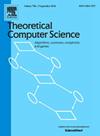Parameterized algorithms for minimum sum vertex cover
IF 0.9
4区 计算机科学
Q3 COMPUTER SCIENCE, THEORY & METHODS
引用次数: 0
Abstract
A minimum sum vertex cover of an n-vertex graph G is a bijection that minimizes the cost . Finding a minimum sum vertex cover of a graph (the MSVC problem) is NP-hard. MSVC is studied well in the realm of approximation algorithms. The best-known approximation factor in polynomial time for the problem is 16/9 [Bansal, Batra, Farhadi, and Tetali, SODA 2021]. Recently, Stankovic [APPROX/RANDOM 2022] proved that achieving an approximation ratio better than 1.014 for MSVC is NP-hard, assuming the Unique Games Conjecture. We study the MSVC problem from the perspective of parameterized algorithms. The parameters we consider are the size of a minimum vertex cover and the size of a minimum clique modulator of the input graph. We obtain the following results.
- –MSVC can be solved in time,where k is the size of a minimum vertex cover.
- –MSVC can be solved in time for some computable function f, where k is the size of a minimum clique modulator.
求助全文
约1分钟内获得全文
求助全文
来源期刊

Theoretical Computer Science
工程技术-计算机:理论方法
CiteScore
2.60
自引率
18.20%
发文量
471
审稿时长
12.6 months
期刊介绍:
Theoretical Computer Science is mathematical and abstract in spirit, but it derives its motivation from practical and everyday computation. Its aim is to understand the nature of computation and, as a consequence of this understanding, provide more efficient methodologies. All papers introducing or studying mathematical, logic and formal concepts and methods are welcome, provided that their motivation is clearly drawn from the field of computing.
 求助内容:
求助内容: 应助结果提醒方式:
应助结果提醒方式:


